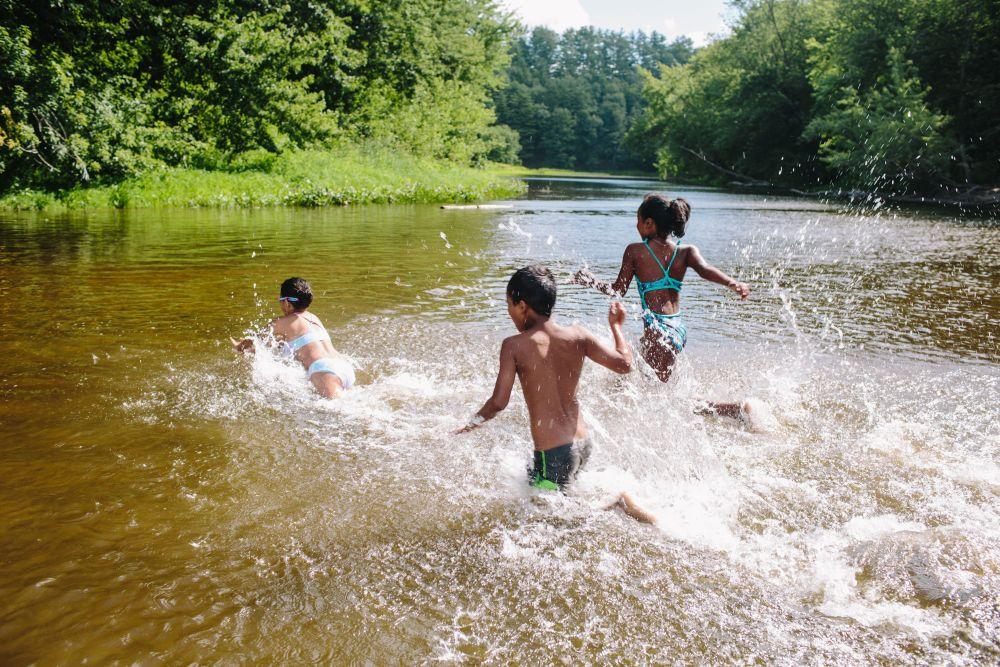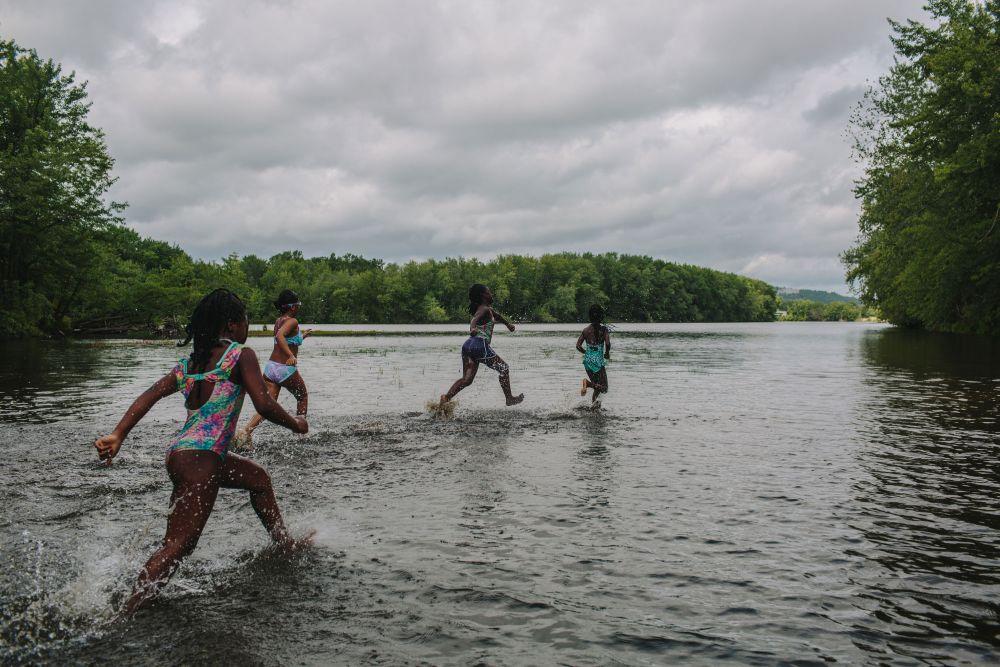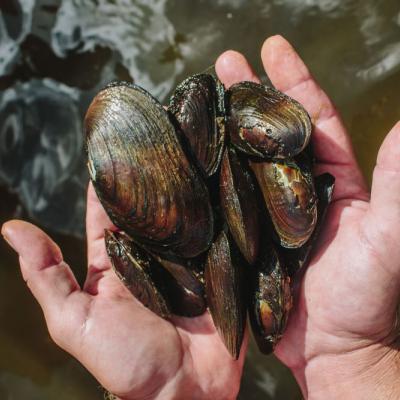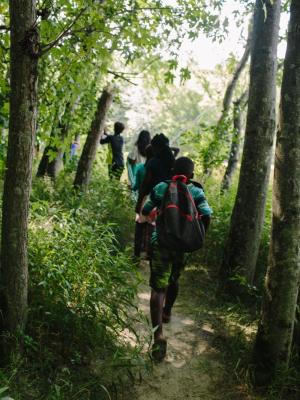What can English Language Learners, so-called “New American” children from Africa and Nepal, teach us about free play in nature?
- Tags:
- Education,
- Clean Water,
- Conservation Center

At the river, the students did not hesitate to wade into the shallow, sandy-bottomed cove. Running, laughing and splashing or flopping in the water ensued. We found freshwater mussels. “Shells!” students enthused.
“I’ll bet a kid from rural Africa could teach you a thing or two about making things out of trees” my colleague said.
It's true.
The summer students from Concord’s Broken Ground Elementary School, located only one mile from the Forest Society Conservation Center visited our Merrimack River Outdoor Education Area for a guided walk - and more importantly - for unstructured free play at the edge of the Merrimack River.
The 12 elementary students are "New Americans," most from families relocated to the Concord area recently by social service agencies with support from area churches. They are enrolled in the English Language Learners program. Their home countries include Tanzania, Rwanda, Burundi, and Nepal.
Two of their five teachers: Alex Crosby and Ellen Kenny, a talented nature photographer, are each familiar with the floodplain. We discussed a field trip: an hour at most for walking and teaching about wildlife and forests which the students interchangeably called a “jungle.”
Our destination was the mouth of Mill Brook, a sandbar at Eastman Cove where a shallow river oxbow meanders east before rejoining the main stem of the Merrimack opposite the NH Technical Institute. The forest here comprises silver maple, a supple tree adapted to grow in sandy-silt and able to withstand ice blocks and the dynamics of seasonal floods. Silver maple is a true native “riparian” (meaning riverside) forest type.
Our plan was to allow an hour at least for wading and free play in the river.
These students, whom others may call “refugees,” ARE different from their American counterparts. Beyond working to learn basic English, they’ve not (yet) forgotten how to play unfettered outdoors. Without stern parental warnings and a structured or scientific approach to plants and animals, I saw the students using their five senses, touching and climbing and eager to experience - and to share. They are tactile learners, wanting to touch plants and trees and sand and water. We talked about poison ivy and showed them which plant.
A teacher related how on another field trip, students were sternly instructed to not touch any trees. “I mean, why not?” she said. Exactly.

I too had some things to remember: finding toads, climbing trees, eating sour cherries, the bitter smell of a pin cherry’s inner bark, finding hickory nuts, oak galls and pine cones and looking closely at leaves and finding inchworms.
I also remembered a short poem “Witness” by poet W.S. Merwin:
I want to tell what the forests were like
I will have to speak in a forgotten language.
- from The Rain In The Trees (1988)
Teacher Ellen Kenny shared how her students relate to plants – not as a kind of green wall or backdrop – but as potential sources of food or medicine. As we walked students exclaimed “bamboo” when we found the segmented stems of scouring rush. They told me how large it grows in their home country and how it can be used for building homes.
Kenny adds “there are usually two or three Nepali girls who are familiar with many of the plants—ferns or plaintain—because ‘In Nepal we eat that one! And that one! Sometime we find here and we pick and eat here too!’ They interact with plants like they were old friends."
A girl spied green milkweed pods and talked of picking them and playing at floating them in a river because they resemble green fish. Kenney adds “No plastic floaties or swim toys: just milkweed pods.” To her students, plants have utility – each plant has a potential use. The kids seem to me to pay closer attention to plants than American kids.
They expressed fewer fears about being outside. I am accustomed to hearing a litany of hazards: mosquitoes, ticks, poison ivy, poison sumac, snakes, spiders, bears. The lack of a New Hampshire equivalent of elephants, lions or tigers presented me with an opportunity to explain the worst we fear are ticks and mosquitoes. Using bug spray mitigates the risk.
Soon, the perceived “danger” stories turned to snakes – because I had asked. They obliged with tales of snakes inhabiting their homelands. I countered with the fact that our common garter snakes are harmless.
At the river, the students did not hesitate to wade into the shallow, sandy-bottomed cove. Running, laughing and splashing or flopping in the water ensued. We found freshwater mussels. “Shells!” students enthused. We talked about mussels as potential food. Soon students had collected half a bushel. “You stimulated a hunting and gathering impulse” offered Kenny.

A half-sunken log became a submersible couch and a boat. Blue flowers of pickerel weed were a place to hunt for insects or frogs. Boys pursued feats of strength and speed. Girls splashed and followed a teacher to search for tiny fish and to see a neon blue damselfly. Another student stayed on the bank building roads and walls of sand while another played at floating logs and removing others, clearing driftwood “like a beaver in reverse” offered one teacher.
We didn’t drag any curriculum guides or formal cookbook lesson plans. On this perfect summer morning in one all-too-brief hour, we created an eddy in the river, a place to play and learn and to share. A student asked if I could “teach him a dance.” A dance of pure joy would have been appropriate. I watched New American children experiencing the Merrimack – the central river of their new home. We shared the opportunity to play and ask questions but it would soon be time to meet the bus…
After collecting sandals and T-shirts from the sandy bank, we gathered for a snack and sat in a circle on the riverbank while looking at the Concord granite quarry, forested hills, the sky - a time to share - so I asked “What’s the name of this river? Where is it going? Where does it come from?” They looked at me; didn’t know.
“What do you hear?” We listened to birdsongs and the sound of traffic on I-93 beyond the trees. Then I told them this is the Merrimack River – it comes from the vast forest of the White Mountains. It flows to the Atlantic Ocean at Newburyport, Mass.
What do you like best about this river? I asked. Hands raised. “It is calm,” meaning (I assume) peaceful in the feeling of sitting next to the river as opposed to tumultuous in its cataracts or currents. Both “swimming” and “finding shells” also rated high.
Then I asked, “Can you tell me about a river in your homeland?” Softly, the students shared stories of remembered places: gathering water to wash bodies or to shower or wash clothing, a place to catch fish for food. A place to swim. One girl told me about crocodiles in the river. But no, not here. These children had already known other rivers.

Welcome to the jungle. I wonder if these kids will always relate naturally to forests, plants, animals and a river. Do they hold up a figurative mirror to their peers who, in my experience, would have likely been less comfortable turned loose to wade and explore, without formal, structured learning activities?
Teacher Kenny explained the value of field trips for English Language Learners:
“Many new American children have sophisticated areas of competency, survival skills, a comfort level in the forest and an understanding of foraging and even living off the land that we do not often get to see—that is not elicited by regular classroom academics-- and we would not likely have discovered, had we NOT had the opportunity to bring them to wild places and watch them roam and explore.
"How unusual for them—and how wonderful—is the opportunity to show us what they can do and what they know, that so many of us do not: about ways to be in and to interact with and understand our—and now their—woods.”
With nearly 30 years’ experience now as a naturalist and environmental educator, I can't imagine a more age-appropriate and immersive experience for learning about a floodplain forest and its river.
It was perhaps the highest and best use of the Concord conservation land that I've ever witnessed.
Naturalist Dave Anderson is senior director of education for The Society for the Protection of New Hampshire Forests. Reach him at danderson@forestsociety.org.
Photos by Emily Lord/Forest Society.
